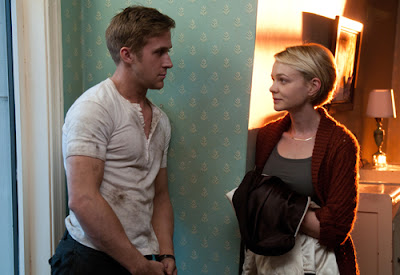The first thing you will notice about "Drive" is the opening credits. They are colored in pink. Outside of the 80's you don't really see pink lettered opening credits. You know how straight dudes that wear pink do so because 1.) They're bold enough to try and pull it off and 2.) They can pull it off? Those pink letters are Danish director Nicolas Winding Refn saying, "Hey, not only am I bold enough to try and pull this movie off, I can pull it off. Watch me."
Action movies - and that's how I think of "Drive", as an action movie, despite not having as many traditional "action" sequences as you might expect - have reached a point where achieving originality in the plot details is virtually impossible. There are only so many cars to chase, police cruisers to flip, guns to be shot, knives to be wielded, bags of cash to be exchanged, etc. So the best action movies that we receive nowadays are almost always exclusive exercises in style. Think of Paul Greengrass heaving all but the barest of story off the balcony and going for pile-driving Shaky Cam Style Extraordinaire in "The Bourne Supremacy." And now here comes Refn's onslaught of actioning panache. "Drive" is damn near all style with twists and turns straight out of a pulpy noir B movie from the 40's, a soundtrack awash in synthesized electro pop, an icy look reminiscent of Michael Mann, and standing at the center as the soft-talking, touch-acting protagonist is a man known only as The Driver, played by Ryan Gosling (employing a toothpick like Mickey Rourke) in a performance that calls to mind the GQ man's Jason Bourne.
The Driver is a mechanic and part-time movie stunt car man for Shannon (Bryan Cranston) and moonlights as a no-nonsense, top-flight getaway driver, which is established in the film's pulsating pre-opening credits sequence that employs its low hum of a music score to full effect and improbably creates a car chase that is filmed so classically and elegantly that it must look to Michael Bay the way Latin on the page looks to me.
Shannon enlists a mob guy named Bernie (Albert Brooks) to front the funds for he and The Driver to purchase a stock car and enter the racing circuit. The Driver Meets Cute with his neighbor Irene (Carey Mulligan, gracefully fetching) who has a young son, Benicio, and a husband in prison. An attraction develops between The Driver and Irene, as it must, but as soon it does Irene's husband, Standard (Oscar Isaac), as he must, gets out and returns home. But it turns out Standard owes a gaggle of money to some nefarious guys who gave him protection when he was locked up in the clink. Standard doesn't have the money. The nefarious guys threaten to go after Irene and Benicio, and when The Driver learns of this development he agrees to assist Standard and an obligatory femme fatale (Christina Hendricks) who seemingly appears out of thin air (vitally important note: Michael Mann would have set her character up) to rob a pawn shop to get the cash to pay off the nefarious guys. The Driver will drive getaway. The robbery goes horribly, fatally wrong. The nefarious guys are on The Driver's tail and in accordance with that ever-vicious Circle Of Life, the trail of the nefarious guys leads directly back to Bernie and his foul-mouthed associate Nino (Ron Perlman). The remainder of the story shall, in this review, remain scarce.
If the film steps wrong, and it does, it is primarily in relation to the villains whose motives seem disappointingly routine and unimportant in comparison to the operatic scope of the rest of the film. At the same time Refn isn't quite as adept as Michael Mann at evoking true romance with singular shots and lingering looks in place of the old war horses dialogue and backstory and consequently the heart beat of the film that is The Driver's emotional attachment to Irene never becomes fully realized and prevents the film's conclusion from having that necessary tragic inevitability of the old noir pictures it's trying so hard to emulate. Please don't misunderstand, I'm not saying this makes "Drive" bad, but it does prevent "Drive" from reaching greatness. Although, perhaps paradoxically, "Drive" does reach greatness in one sequence that will quite likely go down as the finest 120 seconds in a movie this year.
It is a scene set in an elevator. It involves The Driver, Irene and one of the nefarious guys. It is beautiful, romantic and melodramatic and then violent, terrifying and grotesque. It is an illustration of Life & Death and how it flips on a dime. In a way, it's so monumentally perfect the movie can't help but go downhill. That might be unfair, but it might also be right. Refn is as much a character of this film as the characters themselves and the main characters of the best noirs always sealed their own fate. In the end, Refn's extreme auteurism does him in.
Monday, September 26, 2011
Subscribe to:
Post Comments (Atom)





3 comments:
Not sure when I'll see this film but your intro actually makes me real curious to see it. Somehow Refn makes that bold 80s pink looks bad-ass even in the poster!
It's definitely worth a trip to the theater if you get the chance. And if Refn is as stylish with his clothes as with a camera, he's going to leave Javier Bardem in the dust.
On Christina popping up out of nowhere, in a film of occasionally exasperating aspects that has to be the one that exasperated me the most. Criminally underused.
Post a Comment